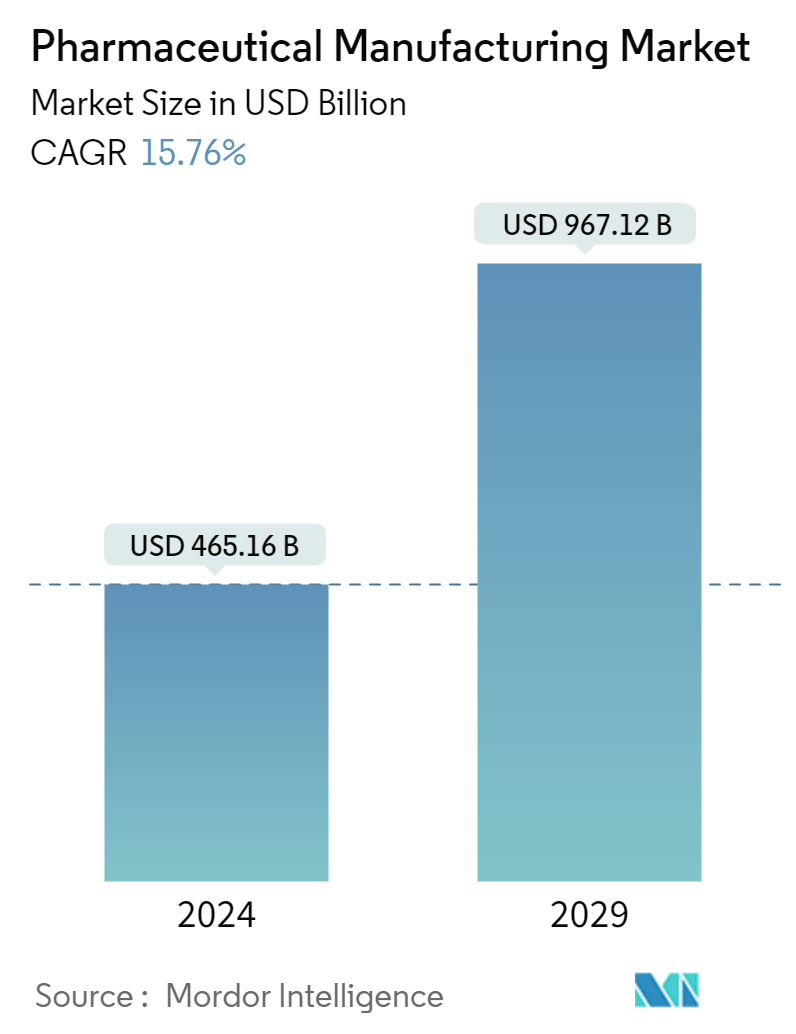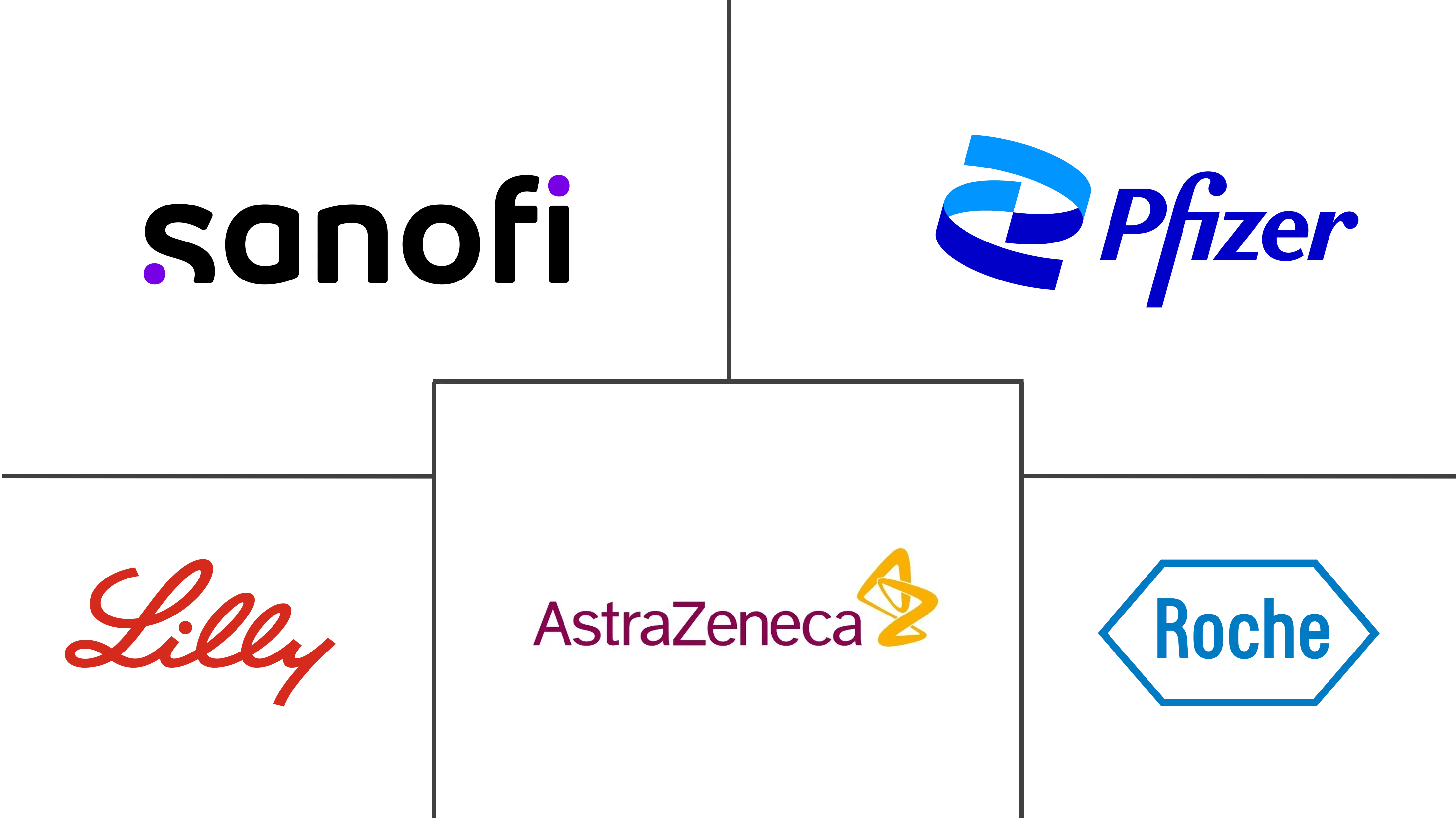Market Size of Pharmaceutical Manufacturing Industry

| Study Period | 2019 - 2029 |
| Market Size (2024) | USD 465.16 Billion |
| Market Size (2029) | USD 967.12 Billion |
| CAGR (2024 - 2029) | 15.76 % |
| Fastest Growing Market | Asia Pacific |
| Largest Market | North America |
Major Players
*Disclaimer: Major Players sorted in no particular order |
Pharmaceutical Manufacturing Market Analysis
The Pharmaceutical Manufacturing Market size is estimated at USD 465.16 billion in 2024, and is expected to reach USD 967.12 billion by 2029, growing at a CAGR of 15.76% during the forecast period (2024-2029).
The pharmaceutical manufacturing market’s growth can be attributed to factors such as increasing research and development expenditure by pharma contract manufacturing companies, advancements in pharmaceutical manufacturing technologies, the growing burden of chronic diseases, and the surge in the geriatric population. The increasing outsourcing volumes by pharmaceutical companies are further expected to propel market expansion over the coming years.
The growing burden of chronic diseases and the surging elderly population are expected to propel the demand for novel pharmaceuticals, thereby driving the pharmaceutical manufacturing market. For instance, according to the American Cancer Society's 2023 update, around 1.93 million new cancer cases were diagnosed in 2023, compared to 1.9 million cases in 2022 in the United States. In addition, per the Centers for Disease Control's National Diabetes Statistics Report for 2022, the expenditure on diabetes in the United States was around USD 37.3 million in 2022. Thus, the high prevalence of chronic diseases globally is projected to spur the demand for pharmaceuticals, thereby driving the market.
According to the pharmaceutical market analysis by the Australian Institute of Health and Welfare, the country recorded 14,800 lung cancer cases in 2023, compared to 14,529 lung cancer cases in 2022. Thus, such statistics are expected to propel pharma manufacturing, thereby facilitating market growth over the coming years.
The increasing emphasis of pharma contract manufacturing companies on expansion and the rising investments to bolster pharmaceutical production are anticipated to contribute to market growth. For instance, in December 2023, Piramal Pharma Solutions (PPS) invested GBP 45 million (USD 57.15 million) to establish a new manufacturing facility to produce antibody-drug conjugate (ADC) in Grangemouth, Scotland, United Kingdom. This helped the pharmaceutical manufacturing company bolster its ADC manufacturing capabilities.
In April 2022, Ferring Pharmaceuticals opened its integrated R&D and manufacturing facility in Hyderabad, with a total investment of EUR 30 million (USD 31.78 million). The manufacturing facility is designed to accelerate the manufacturing of solid dosage formulations. Owing to the above-mentioned factors, such as the rising burden of chronic disease and the expanding pharmaceutical sector, the pharma manufacturing market is expected to grow significantly over the forecast period.
The increasing research and development efforts by pharmaceutical and biopharmaceutical companies are further projected to accelerate pharmaceutical manufacturing, thereby supporting the market’s growth. As per the European Federation of Pharmaceutical Industries and Associates data of June 2023, the R&D expenditure of European pharma companies increased from EUR 42,533 million in 2021 to EUR 44,500 million in 2022. Thus, the increasing R&D expenditure by pharmaceutical manufacturing companies is projected to spur pharma activities, including production, thereby supporting market expansion.
Advancements in pharmaceutical manufacturing technologies, the growing burden of chronic diseases, and the increasing R&D spending by pharma manufacturing companies are anticipated to support market growth over the coming years. However, the pricing pressure of biopharmaceutical and pharmaceutical companies and stringent regulations impede the market's growth.
Pharmaceutical Manufacturing Industry Segmentation
As per the report's scope, pharmaceutical manufacturing is the industrial-scale synthesis of pharmaceutical drugs as part of the pharmaceutical industry. Drug manufacturing can be broken down into unit operations, such as milling, granulation, coating, and tablet pressing.
The pharma manufacturing market is segmented by molecule type, drug development type, formulation, application, prescription type, and geography. By molecule type, the market is segmented into biologics and biosimilars (large molecules) and conventional drugs (small molecules). By drug development type, the market is segmented into outhouse and in-house. By formulation, the market is segmented into tablets, capsules, injectables, sprays, and other formulations. By application, the market is segmented into cancer, diabetes, cardiovascular diseases, neurological diseases, respiratory diseases, and other application types. By prescription type, the market is segmented into prescription medications and over-the-counter medications. The report also covers the market sizes and forecasts for major countries across different regions. For each segment, the market size is provided in terms of value (USD).
| By Molecule Type | |
| Biologics and Biosimilars (Large Molecules) | |
| Conventional Drugs (Small Molecules) |
| By Drug Development Type | |
| Out-house | |
| In-house |
| By Formulation | |
| Tablets | |
| Capsules | |
| Injectables | |
| Sprays | |
| Other Formulations |
| By Application | |
| Cancer | |
| Diabetes | |
| Cardiovascular Diseases | |
| Neurological Diseases | |
| Respiratory Diseases | |
| Other Applications |
| By Prescription Type | |
| Prescription Medications | |
| Over-the-counter Medications |
| By Geography | ||||||||
| ||||||||
| ||||||||
| ||||||||
| ||||||||
|
Pharmaceutical Manufacturing Market Size Summary
The pharmaceutical manufacturing market is poised for substantial growth over the forecast period, driven by several key factors. Increasing research and development expenditures by pharmaceutical contract manufacturing companies, along with advancements in manufacturing technologies, are significant contributors to this expansion. The rising prevalence of chronic diseases and the growing geriatric population are expected to boost the demand for novel pharmaceuticals, further propelling market growth. Additionally, the trend of outsourcing by pharmaceutical companies is anticipated to enhance market dynamics. The biologics and biosimilars segment is projected to hold a significant share, supported by the increasing demand and approvals of biologics, as well as a heightened focus on biosimilar manufacturing due to their cost-effectiveness and similar efficacy to biologics.
Regionally, North America is expected to maintain a significant market share, bolstered by the presence of major pharmaceutical manufacturers and increased spending on manufacturing. The high burden of chronic diseases in the region is likely to drive pharmaceutical demand, thereby fostering production. The adoption of advanced manufacturing technologies in the United States, along with its status as a top outsourcing destination, is projected to further support regional market growth. The competitive landscape of the pharmaceutical manufacturing market is characterized by the presence of numerous global players, with companies employing various growth strategies such as partnerships, expansions, and technological advancements to enhance their market presence.
Pharmaceutical Manufacturing Market Size - Table of Contents
-
1. MARKET DYNAMICS
-
1.1 Market Overview
-
1.2 Market Drivers
-
1.2.1 Increasing Research and Development Expenditure by Pharmaceutical Companies
-
1.2.2 Advancements in Pharmaceutical Manufacturing Technologies
-
1.2.3 Growing Burden of Chronic Disorders and Geriatric Population
-
1.2.4 Rise in the Use of Outsourcing by Pharmaceutical Companies for Drug Development
-
-
1.3 Market Restraints
-
1.3.1 Pricing Pressure of Biopharmaceutical and Pharmaceutical Companies
-
1.3.2 Stringent Regulations
-
-
1.4 Porter's Five Forces Analysis
-
1.4.1 Bargaining Power of Suppliers
-
1.4.2 Bargaining Power of Buyers/Consumers
-
1.4.3 Threat of New Entrants
-
1.4.4 Threat of Substitute Products
-
1.4.5 Intensity of Competitive Rivalry
-
-
-
2. MARKET SEGMENTATION (Market Size by Value - USD)
-
2.1 By Molecule Type
-
2.1.1 Biologics and Biosimilars (Large Molecules)
-
2.1.2 Conventional Drugs (Small Molecules)
-
-
2.2 By Drug Development Type
-
2.2.1 Out-house
-
2.2.2 In-house
-
-
2.3 By Formulation
-
2.3.1 Tablets
-
2.3.2 Capsules
-
2.3.3 Injectables
-
2.3.4 Sprays
-
2.3.5 Other Formulations
-
-
2.4 By Application
-
2.4.1 Cancer
-
2.4.2 Diabetes
-
2.4.3 Cardiovascular Diseases
-
2.4.4 Neurological Diseases
-
2.4.5 Respiratory Diseases
-
2.4.6 Other Applications
-
-
2.5 By Prescription Type
-
2.5.1 Prescription Medications
-
2.5.2 Over-the-counter Medications
-
-
2.6 By Geography
-
2.6.1 North America
-
2.6.1.1 United States
-
2.6.1.2 Canada
-
2.6.1.3 Mexico
-
-
2.6.2 Europe
-
2.6.2.1 Germany
-
2.6.2.2 United Kingdom
-
2.6.2.3 France
-
2.6.2.4 Italy
-
2.6.2.5 Spain
-
2.6.2.6 Rest of Europe
-
-
2.6.3 Asia-Pacific
-
2.6.3.1 China
-
2.6.3.2 Japan
-
2.6.3.3 India
-
2.6.3.4 Australia
-
2.6.3.5 South Korea
-
2.6.3.6 Rest of Asia-Pacific
-
-
2.6.4 Middle East and Africa
-
2.6.4.1 GCC
-
2.6.4.2 South Africa
-
2.6.4.3 Rest of Middle East and Africa
-
-
2.6.5 South America
-
2.6.5.1 Brazil
-
2.6.5.2 Argentina
-
2.6.5.3 Rest of South America
-
-
-
Pharmaceutical Manufacturing Market Size FAQs
How big is the Pharmaceutical Manufacturing Market?
The Pharmaceutical Manufacturing Market size is expected to reach USD 465.16 billion in 2024 and grow at a CAGR of 15.76% to reach USD 967.12 billion by 2029.
What is the current Pharmaceutical Manufacturing Market size?
In 2024, the Pharmaceutical Manufacturing Market size is expected to reach USD 465.16 billion.

